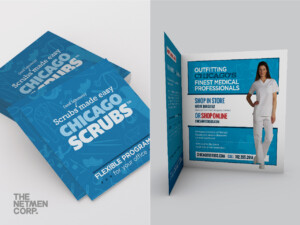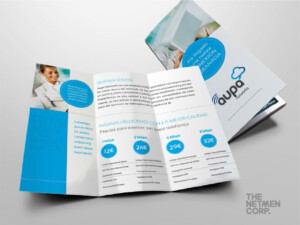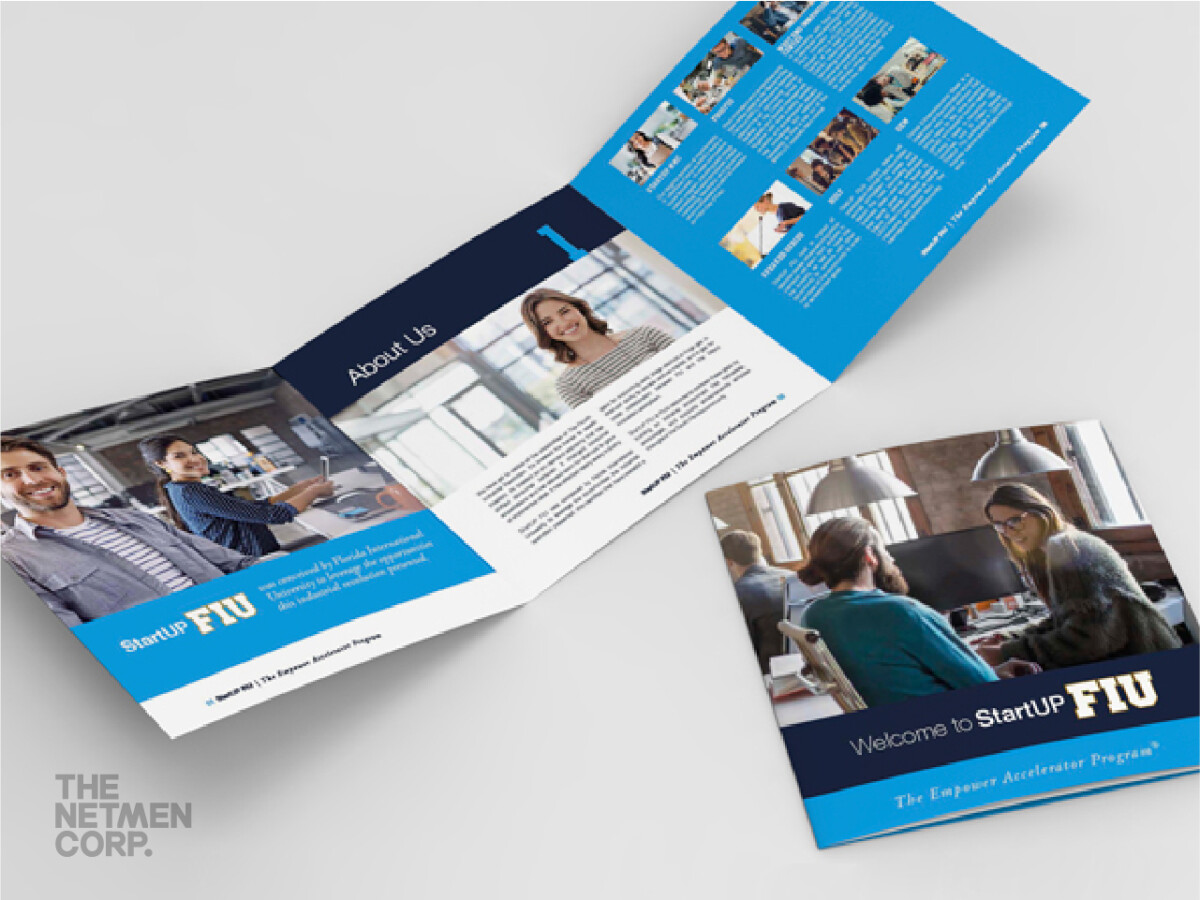How to Make a Trifold Brochure
Trifold brochures are powerful marketing tools that can effectively showcase your business. When you decide to create one, working with a professional design firm can elevate your brochure’s quality and impact.
This guide will walk you through the essential steps to prepare for collaborating with a design firm. By following these tips, you’ll ensure a smooth process and a stunning final product.
Understanding Trifold vs. Bifold
Before diving into the design process, it’s crucial to understand your options. Trifold brochure designs feature three sections, while bifold brochures have two. Bi fold brochures are simpler and work well for concise messages.
Trifolds, on the other hand, offer more space for detailed information. Consider your content needs and discuss your preference with the design firm to ensure you choose the right format for your message.

Professional bifold brochure design by The NetMen Corp
Setting Clear Goals
The foundation of a successful brochure project lies in setting clear goals. Before meeting with the design firm, ask yourself these key questions:
- Who is the target audience for this brochure?
- What is the main message you want to convey?
- What action do you want readers to take after viewing the brochure?
Having clear answers to these questions will guide the design process and help the firm create an effective brochure trifold that meets your objectives.
Gathering Essential Information
Collecting key details about your business before meeting with the design firm can streamline the process. Prepare a document that includes:
- Company background and history
- Target audience demographics and preferences
- Unique selling points of your products or services
- Complete contact details
- Website and social media links
This information helps designers understand your brand and create a brochure that aligns with your overall marketing strategy.
Deciding on Content
Planning your brochure’s content is a crucial step in the preparation process.
- Attention-grabbing headlines
- Key points about your offerings
- Detailed product or service descriptions
- Customer testimonials or case studies
- Call-to-action statements
Organize this information into a logical flow. Remember, the design firm will help refine and structure your content, but having a clear idea of what you want to communicate will make the process more efficient.
Collecting Visual Elements
Visual components play a significant role in brochure design. Gather all relevant visual materials to share with the firm, including:
- Your company logo in high-resolution format
- Brand style guide (if you have one)
- High-quality product or service photos
- Team photos or headshots
- Infographics or charts relevant to your message

Considering Branding Guidelines
Consistency in branding is key to creating a recognizable and impactful brochure. Review your existing brand guidelines and prepare to share them with the design firm. These guidelines typically cover:
- Color palette
- Typography choices
- Overall visual style
- Tone of voice for written content
By adhering to these guidelines, the design firm can create a brochure that seamlessly integrates with your other marketing materials.
Exploring Design Preferences
To help the design firm understand your aesthetic preferences, take some time to explore existing brochures or designs that appeal to you. Pay attention to elements like color schemes, layout styles, font choices, and image use to make your design more eye catching.
Collect examples to share with the firm, explaining what you like about each one. This visual reference can be invaluable in guiding the design process.
Understanding the Design Process
Familiarizing yourself with the typical design process helps set realistic expectations. Most graphic designers follow a similar workflow:
- Initial consultation: Discuss your needs and goals.
- Concept development: The firm creates initial design ideas.
- Design drafts: You’ll receive initial layouts for review.
- Revisions: Feedback is incorporated into the design.
- Final approval: You sign off on the final design.
- Print preparation: Files are prepared for printing.
Preparing for the Initial Meeting
Familiarizing yourself with the typical design process helps set realistic expectations. Most design firms follow a similar workflow:
- Initial consultation: Discuss your needs and goals.
- Concept development: The firm creates initial design ideas.
- Design drafts: You’ll receive initial layouts for review.
- Revisions: Feedback is incorporated into the design.
- Final approval: You sign off on the final design.
- Print preparation: Files are prepared for printing.
Asking the Right Questions
Don’t hesitate to ask the frequently asked questions during your interactions with the design firm. Some key questions to consider include:
- What is your experience with trifold brochures or single fold brochures?
- Can you walk me through your design process?
- What’s a typical timeline for a project like this?
- What’s your policy on revisions?
- Do you offer printing services or recommend printers?
- Do you offer other print design services like business card design?
Good communication leads to better results, so don’t be shy about seeking clarification or additional information.
Planning for Digital Use
In today’s digital age, consider how your brochure might be used online. Discuss with the design firm:
Creating a web-friendly version of the brochure Designing with both print and digital use in mind Options for interactive PDF formats
A digital version extends your brochure’s reach and provides more flexibility in how you share your message.
Setting a Realistic Timeline
Establish a clear timeline for the project. Consider factors such as:
- Time needed for design work
- How many revision rounds you anticipate
- Printing time
- Any hard deadlines you’re working towards
A well-planned timeline keeps the project on track and ensures you have your brochures when you need them.
Preparing for Feedback
Your feedback is crucial in shaping the final design. To make the revision process smooth and effective:
- Be specific in your comments
- Explain the reasoning behind requested changes
- Prioritize your feedback
- Stay open to the designer’s professional advice
Constructive feedback leads to improvements and helps achieve the best possible outcome.
Conclusion
Preparing to work with a design firm takes effort. But it’s worth it. Good preparation leads to better brochures. Follow these steps for a smooth process. Remember, clear communication is key. With the right preparation, you’ll create a trifold brochure that shines.
Working with a print design service can transform your marketing. A well-designed trifold brochure catches eyes and shares your message effectively. Start your design journey well-prepared for the best results.



